Canis Dirus, The Fearsome Dogs - A Pack Long Forgotten
Did you ever wonder if the wolves did face extinction? Did the Extinction event take a toll on the wolves? Well, they did face extinction years ago and won the fight against extinction. However, during the period of a Dire extinction event, they did lose some of the wolves on the road to victory, as a matter of fact, a very rare species called the Canis dirus.
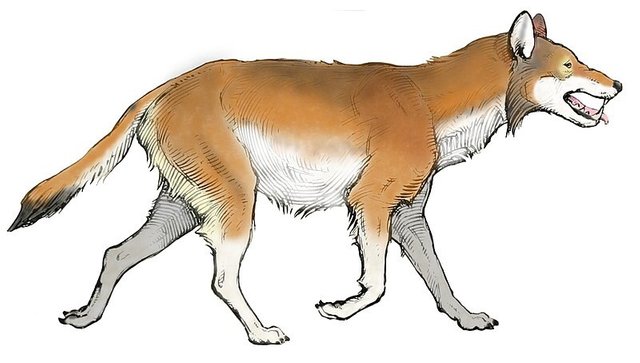 Wikimedia: Dire Wolf by Erwin S. Christian, image available under CC BY-SA 3.0
Wikimedia: Dire Wolf by Erwin S. Christian, image available under CC BY-SA 3.0
Basically, they were popularly known as the Fearsome Dogs, a lot like those you see on most movie series like GOT. Now, I know the name sounds a little bit scary, Yes and that’s because in actual sense they were fearsome beasts that challenged the other species alike, in nature, size and hyper senses. In the series, " Game of Thrones ", you would have already been acquainted with a pack of wolves in the series. The Dire wolf pack were known for their fearsome nature, feared by humans and animals alike and trust me, they were real and most of all, terrifying. So the question is since they were so fearsome and wild in nature as history has enlightened us then, why did they go extinct?
In today’s article, we would try to find out why they went extinct and see if there are traces still left of the dire wolf and other related species furthermore, discuss some facts about the Canis Dirus and also seek to unlock the myth behind their extinction as species, gathering fossils records for more information on their structure and, where they might have lived in relation to their extinction.
A Descriptive Insight; The Canis Dirus
In trying to really give a detailed and more efficient description of this species, fossils records of the Canis Dirus were analyzed critically, together with other animals, relative to its extinction. Canis Dirus dates back to the ancient history of an ancestral line of wolves and are the largest canines to have walked the Earth.
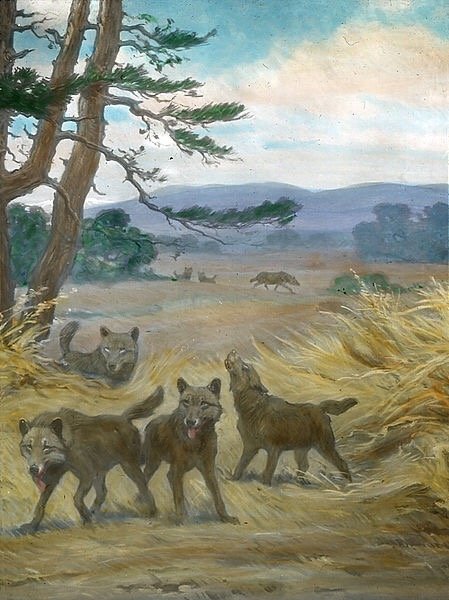 Dire wolf (Canis dirus) from Rancho La Brea, by Charles R. Knight image available under CC BY-SA 3.0
Dire wolf (Canis dirus) from Rancho La Brea, by Charles R. Knight image available under CC BY-SA 3.0
Dire wolves were basically large animals of the class Mammalia, scientifically called ”Canis Dirus” meaning ’ Fearsome dog’, having the looks of the modern-day Grey wolf, a known counterpart to the Dire wolves. The Grey wolves did coexist together with the dire wolves, except that at the beginning of one species’ extinction a pathway was created for the other species’ evolution. Not only did they have to compete with the greatest threat “Extinction”, D.wolves had to also compete with the now extinct species; the Saber-toothed tigers alongside the ice age Wolly Mammoth. They shared the same habitat, choice of meal, who knows they may have killed each other over a hunt gone bad or for domination. Dire wolves were simply predators of the Pleistocene era, the largest of the wolves in general but what really made them more distinct was their large masculine body and heavy structure.
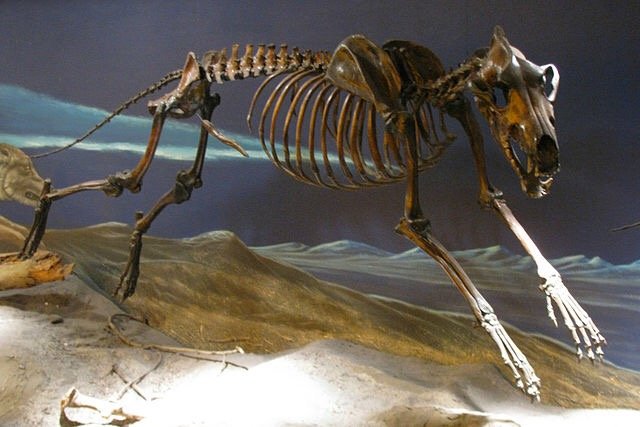 Wikimedia: Dire Wolf Skeleton, by Eden, image available under CC BY-SA 2.0
Wikimedia: Dire Wolf Skeleton, by Eden, image available under CC BY-SA 2.0
Amongst the Genus Canis, the Fearsome dog(Dire Wolf) had a pretty large body size and weight I might add. However dire wolves had a similar look to dogs, if you looked at them you could easily say they were dog-like in nature but it is safe to say that they were distant cousins. They lived from about 250,000 years ago to 10,000 years ago and were first discovered in the 19th century, named by Joseph Leidy a scientist and Physician in the late 50’s. Dire wolves were estimated to have weighed about 160-240 pounds, having more stronger and thicker bones and a dire wolf was estimated to be 5 feet long and twice as long as its other coexisting species ”the coyote”, this made them bigger than the Grey wolves and coyotes. Dire wolves weren't really fat but rather big boned, robust and fully built. Significantly, the skull of a dire wolf was precisely large, with a prominent sagittal crest, having canines twice the size of a Grey wolf.
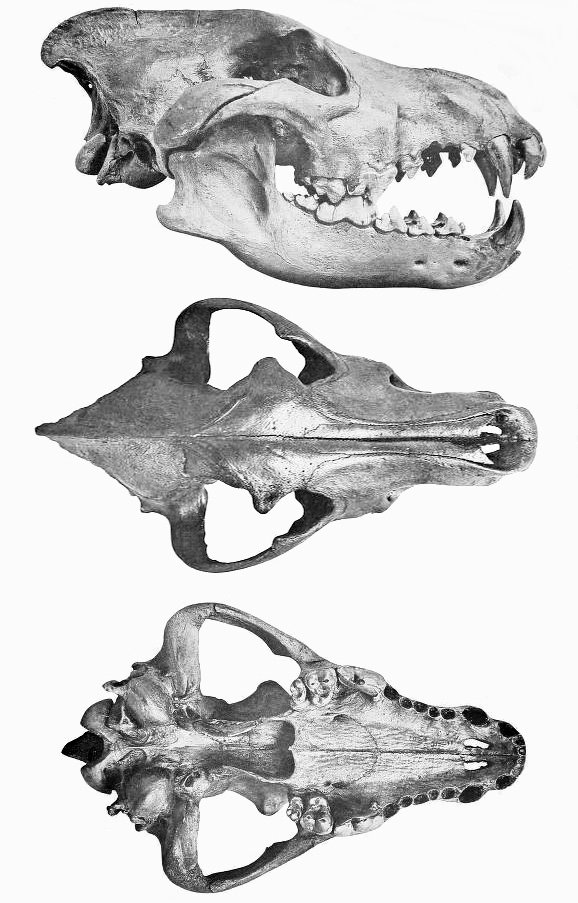 Wikimedia: The Skull of A Dire Wolf, by John Campbell, available under CC BY-SA 3.0
Wikimedia: The Skull of A Dire Wolf, by John Campbell, available under CC BY-SA 3.0
Most male dire wolves were about the same size as the females and some others were just larger in size. Another unique fact about the dire wolf is that it has a much heavier and broader head size, it’s skull length is about 29.5cm, its upper canine teeth 3.175cm and a wider jaw width. In addition to its size, the dire wolf possessed a bone-crushing canine that was 30% stronger than any existing wolf till date and further research has shown that their bite was capable of breaking through the bones of a Hyaena.
A Natural Habitat For The Fearsome Dog
Having established a genuine detail of the dire wolves’ nature, size and its origination, it thereby leaves us with a few other questions like, where did they live? What was living like for this extinct species? How did they feed?
In the mid-nineteenth century, before the event of extinction, the Fearsome dogs were geographically widespread between the Native North and South America and there's no perfect conclusion that they indeed originated from South America but it is said that Dire wolves did roam the woods and grasslands of Canada, Alaska, Florida and even Latin America. In favor of environments, they would prefer a much wetter and cool environment that is situated around lakes, rivers and streams, and mountain areas where they live in packs. The first ever fossils of a dire wolf was traced down to Indiana, a place called Evansville, and was discovered by Francis Linck in the 50’s.
What Did They Eat; The Horses Or The Bisons?
D. Wolves were primarily hunters of Horses and bison, they weren't exactly the kind of wolves to hunt smaller and less appetizing preys, well little did they know that it would end their long-lasting line.
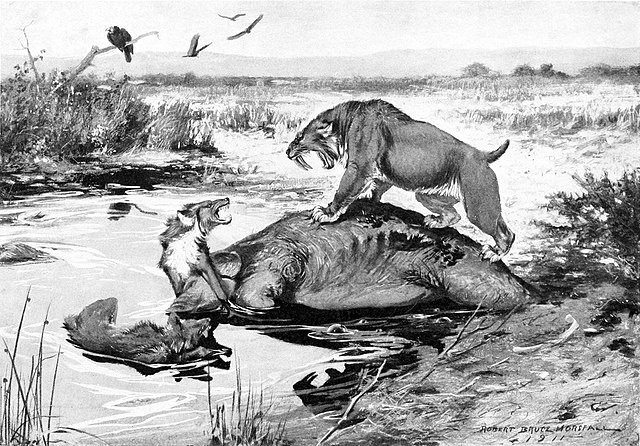 D.wolves and S.tiger fight over a meal, Source: Wikimedia
D.wolves and S.tiger fight over a meal, Source: Wikimedia
Hunting
Dire wolves, like all other wolves, did hunt in a pack but unlike the G.wolves they haunted pretty big animals. During a hunt, a pack of about 25-30 D.wolves go out on the field because they had a thing for horses they’d attack the beautiful hoofed animal well they didn't exactly see them as beautiful but only as a meal but I would say it was really a means to their demise. Although D.wolves weren't so smart like grey wolves at least they possess a rather magnificent amount of strength. They had speed and acted swiftly when hunting, and besides feeding on the horses and bison, Carmel, Mastodon and giant ground sloth were a perfect choice if they had to change their diet.
Feeding
Once the targets (prey) are down the D.wolves now have enough to feed and because they possess very strong teeth, they able to tear through the flesh and crush the bones of their meal ultimately. They didn't exactly have the teeth for eating only tearing so there's a 90% chance that they swallowed big cuts of meat after tearing them and one genuine detail I should add is that they really did feed properly well, I mean they had good meals!
Facing Extinction; The Epoch
Just like the very popular and fearsome cat ”Saber-toothed Tiger”, the Dire wolves did go extinct as fearsome as they were but, the question still remains, Why or better still, How?
It All Started With The Lack Of Preys
11,000 years ago a high-level extinction event occurred during the Pleistocene era and threatened the very existence of our species all over the world, I mean it basically endangered all of them, some survived the epoch, others barely did and some didn't make it through the first few years. After this event, a large number of mammals and herbivores were extinct including the Dire wolves.
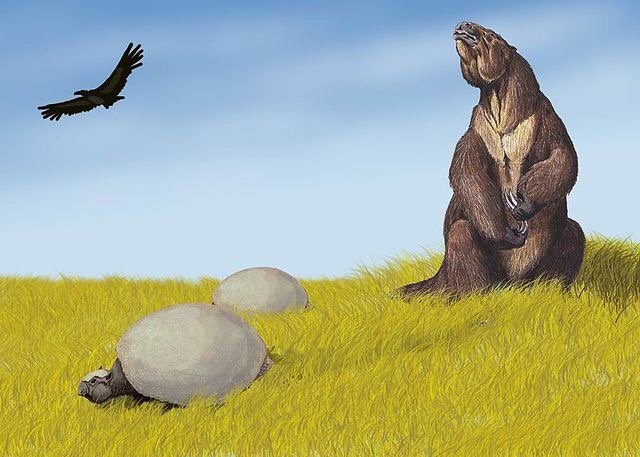 Wikimedia: A picture of the late Pleistocene era, South America, by Digbd available under CC BY-SA 3.0
Wikimedia: A picture of the late Pleistocene era, South America, by Digbd available under CC BY-SA 3.0
The need to hunt and devour more enormously large prey, was the only way that a pack of wolves could get a meal, so the hunt for larger preys began and the D.wolves weren't exactly aiming for something small because they’d prefer to hunt and kill horses well, this wasn't a problem for these fearsome wolves until the Saber-toothed tigers jumped into the scene. S.tigers preferred to hunt what was left in the woods because they had no choice, they had to survive too, predictably, this singular act of survival placed the D.wolves in competition and often times they would hunt down a prey and fight over the same prey, this was an aftermath of the event. Meanwhile, the G.wolves migrated to the East for survival, they didn’t really like the competition while hunting, they split into two groups and ultimately formed the domestic animals we know now as Dogs, the Red Wolves migrated to southeastern America where they diverted to hunting smaller preys and this smart move has kept them alive and kept them through the extinction event till date.
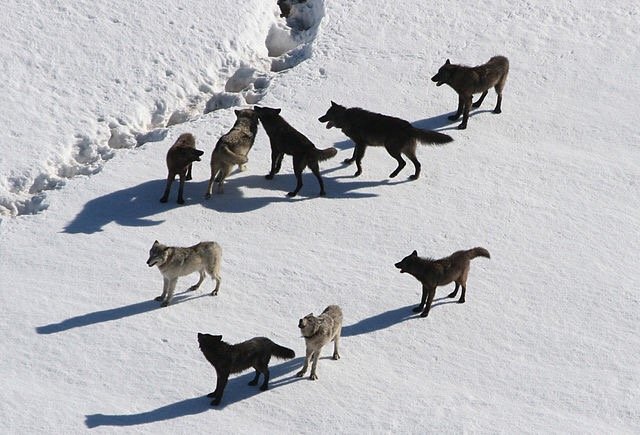 Wikimedia: Grey Wolf Pack by Doug Smith, now in public domain
Wikimedia: Grey Wolf Pack by Doug Smith, now in public domain
Over time, the D.wolves began to have major challenges in feeding, they weren’t getting so much in the way of preys, the hustle for food became more intense as S.tigers challenged their hope of survival. On the other hand, some preys were affected by the event so the woods were filled with fewer preys(Herbivores) and more D.wolves and S.tigers. Eventually, the lack of vegetation drove them into hiding, their numbers reduced by 50% in less than a month leaving them prone to attack and so they were possibly haunted down by early humans in the Pleistocene era.
However, some theories have blamed the extinction of the D.wolves on the lack of preys and though their extinction happened a lot quicker, it would still be reasonable to say they died of starvation and were permanently extinct after the last ice age.
The Fallouts; Bringing It Together
Years after the event of extinction, history shows that the dire wolves were actually fascinating creatures and that these Fearsome dogs exhibited A great level of survival strategy as well the S.tigers but as nature will have it they couldn't make their way to victory, maybe due to the climate condition or the lack of prey and their extinction will always be a mystery left unsolved because no one really knows why they were extinct as well as the reason why the Grey wolves and Coyotes jumped into the victory side though there have been theories. Furthermore, the nature and origin of D.wolves is a remarkable choice o fstudy because they were a force to be reckoned with in the animal kingdom but couldn't make it through to the end.
References
I didn't know dire wolves ever actually existed! Very interesting!
@sustainablyyours Well Not even I knew at first but when I saw the GOT series and the wolves in it, how big they were, I thought to my self they could have existed....
Dangerous 😲
Posted using Partiko Android